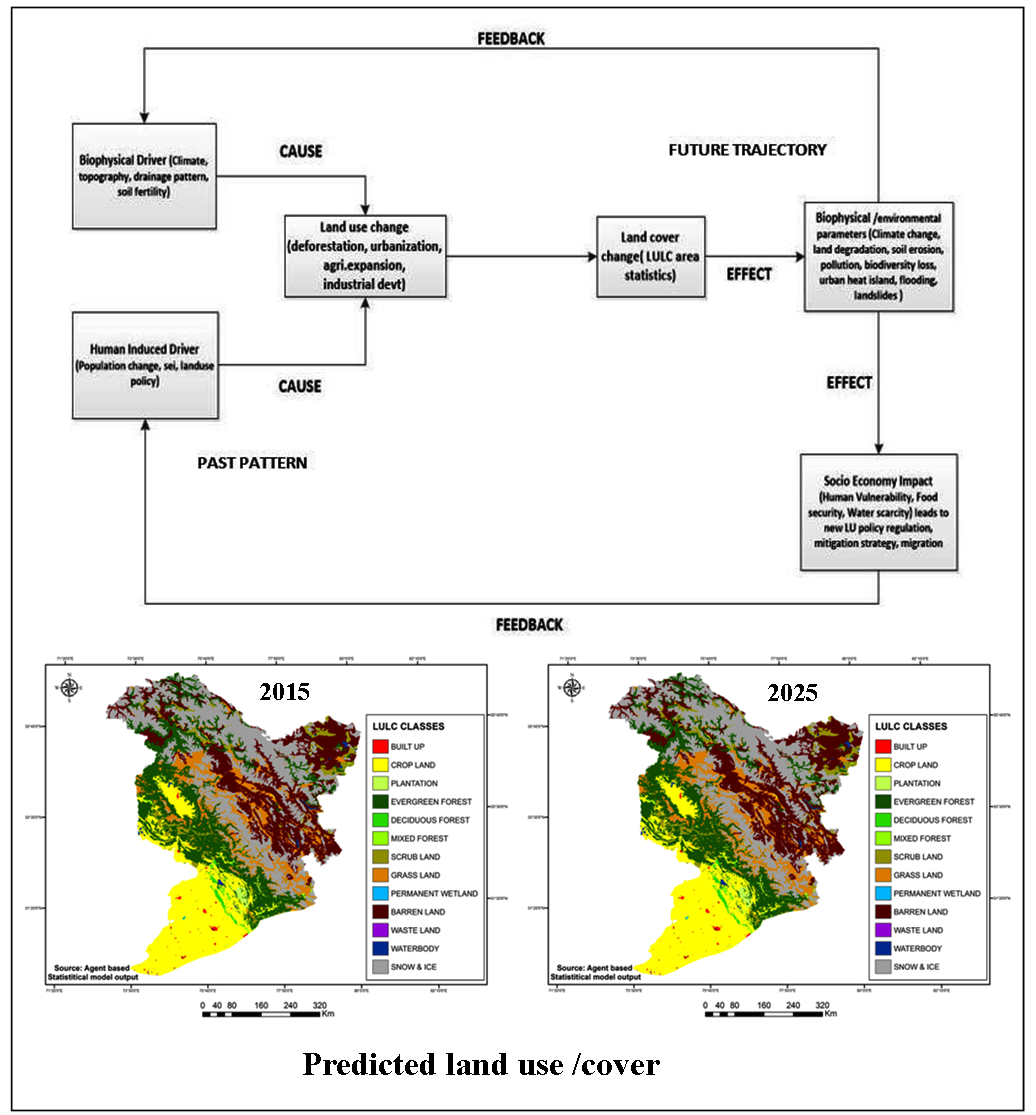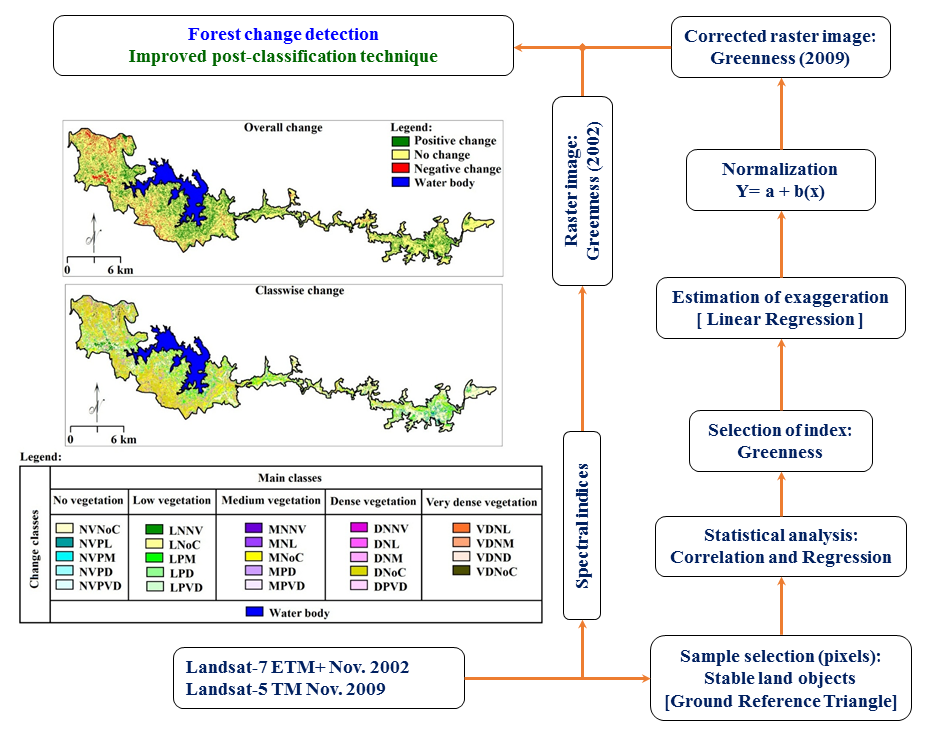Article Title :
Driver based statistical model for simulating land use/land cover change in Indus river basin India 
2 (2018)
15-30
Transition probability , Multiple regression , Model Validation , Socio-economic change , Drivers of change , Land use/Land cover , Land use/land cover dynamics


The main objective of the present study is to project the future scenario of land use/ land cover on the basis of their past pattern of change. Indus basin with its diverse physiography is an ideal study area. Remote sensing sources from Landsat (MSS), LISS-I and LISS-III (1985–2005), were used to assess the past land use at a scale of 1:250,000. A statistical driver-based model was used to simulate the land use scenarios for 2015 and 2025. The model output was validated by comparing the simulated maps with reference ones for 2005 and 2015. All the land use classes displayed an overall accuracy of 85–90% with the exception of the classes “built-up” and “wasteland”.

Indus valley has unique physiography and strategic significance for water resources and climate change impacts.
There was a gradual but significant rise in the built up area, a major reduction in the acreage of cultivated land with time.
The study evaluates a dynamic land use simulation model developed to predict future land use scenarios of the basin on the basis of its past processes of change.
Physiographic and socio-economic drivers were used to predict the future land use land cover.
LULC classes over the basin area were modelled using a combination of transition probability and regression equation based on their past pattern of change with an average accuracy of 80 to 85%.
Agarwal, C., Green, G. M., Grove, J. M., Evans, T. P. and Schweik. C. M. 2001. A review and assessment of land-use change models: Dynamics of space, time, and human choice. Bloomington, IN: South-Burlington, Centre for the Study of Institutions Population, and Environmental Change, Indiana University.
Campbell, D., and Campbell, S. 2008. Introduction to Regression and Data Analysis. StatLab Workshop Series, 2008.
Eastman, J.R., Solorzano, L.A., and Van Fossen, M. 2005. Transition potential modeling for land-cover change. In: Maguire DJ,Batty M, Goodchild MF (eds) GIS, spatial analysis and modeling. ESRI Press, Redlands, 357-385.
IGBP, 1995. Land use and Land cover change. Science/ Research plan (Ed.) Turner B L, Skole D, Sanderson S, Fischer G, Fresco L and Leemans IGBP report 35/ IHDP report 7, Stolkholm and Geneva, IGBP/IHDP
Kumar, M. and Rajan, K.S. 2014. Modelling Land-Use Changes in Godavari River Basin: A Comparison of Two Districts in Andhra Pradesh. 7th Intl. Congress on Environmental Modelling and Software, San Diego, California, USA Daniel P. Ames, Nigel W. T. Quinn, Andrea E. Rizzoli (Eds.).
Menerd, S. 2001. Applied logistic regression analysis (2nd Ed.). Newbury Park, CA: Sage.
Parvez, M.R., Madurapperuma, B., and Ripplinger, D. 2015. Modeling Land Use Pattern Change Analysis in the Northern Great Plains: A Novel Approach. In: 2015 Agricultural & Applied Economics Association and Western Agricultural Economics Association Annual Meeting, San Francisco, CA, July 26-28.
Pijanowski, B. C., Machemer, T., Gage, S., Long, D., Cooper, W., and Edens, T. 1995. A land transformation model: integration of policy, socioeconomics and ecological succession to examine pollution patterns in watershed. Report to the Environmental Protection Agency, Research Triangle Park, North Carolina. 72.
Pijanowski, B. C., Machemer, T., Gage, S., Long, D., Cooper, W., and Edens, T. 1996. The use of a geographic information system to model land use change in the Saginaw Bay Watershed. Proceedings of the Third International Conference on GIS and Environmental Modeling, Sante Fe, New Mexico, January 21-26, 1996. GIS World Publishers on CD-ROM.
Rashid, A., Sayyed, M. R. G., and Bhat F. A. 2015. The dynamic response of Kolohai Glacier to climate change. Proceedings of the International Academy of Ecology and Environmental Sciences, 5(1), 1-6.
Rawlings, J.O., Pantula, S.G., and Dickey, D.A. 1998. Applied regression analysis: a research tool. (2nd Eds.) Springer-Verlag New York Berlin Heidelberg.
Soesbergen, A.V. 2015. A review of Land use Change Models. UNEP World Conservation Monitoring Centre. Cambridge. UK.
Venter, O., Sanderson, E. W., Magrach, A., Allan, J. R., Beher, J., Jones, K. R., Possingham, H. P., Laurance, W. F., Wood, P., Fekete, B. M., Levy, M. A. and Watson, J. E. M., 2016. Sixteen years of change in the global terrestrial human footprint and implications for biodiversity conservation. Nature Communications, 7 (12558).





